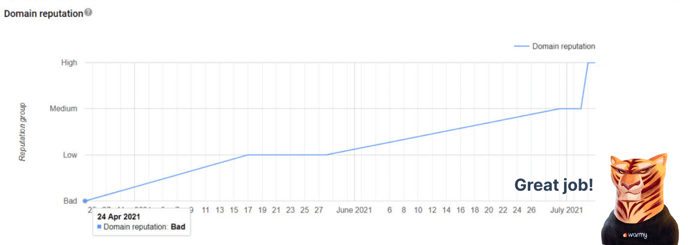The world does not stand still, and the world of email marketing does not sleep either. Email services are improving their spam filters, email marketers are inventing new ways to bypass email filters. 📬
What is the domain warm-up for?
Now mail providers block new IP addresses if a large number of emails suddenly starts coming from them. They perceive you as a spammer. To do bulk mailings, a domain must have a good reputation, and it takes time to earn it.
In this regard, it is better to limit the speed of sending emails at the initial stage. We recommend starting with a low number of emails. If you are just starting to gain a base of your subscribers, then this speed will be quite enough for you at the initial stage.
But if you want to pick up speed quickly enough, then the gradual set of the subscriber base can be accelerated by warming up the domain.
What is domain reputation?
Domain reputation is determined by mailbox providers and internet service providers (ISPs), which means that you might have a different domain reputation for each email service provider. For instance, Gmail might assign you one domain reputation, but messages sent to Yahoo addresses are given a completely different score.
Just understanding the concept of domain reputation isn’t enough to help you manage yours. You also need a strong understanding of how your domain reputation is calculated.
It’s a complicated topic since each email receiver assesses domain authority differently.
While they all have various criteria, not all of them are known. Some services keep their calculation factors a secret, so malicious spammers can’t game the systems.
While the various factors may differ, the one thing that remains constant is that the receiving platform determines how your domain is used in your email messages and then monitors how its users receive those messages.
All scores calculated for each message you send out work for or against you in the future when it’s time to send more messages.
That’s why every domain has multiple reputations associated with different email receivers. Those reputations are also dependent on the volume you’re sending to specific receivers.
For example, if you’re sending the bulk of your email blasts to Gmail users, Google will have a lot of information about your domain and how reputable it is. However, if you only have a few Hotmail subscribers, then that service won’t be able to get a complete gauge on you.
How long do I need to warm up?
How long it takes to warm up is a very controversial issue and depends on many factors.
For example, if your domain or mailbox is brand new, it is recommended to warm up for at least 2 months and reach the maximum possible limits for sending emails per day, which will greatly help in your future cold mailings to a large number of recipients.
If your domain is not new then achieving good results will depend on your current reputation, which you can periodically check with the help of various postmasters that will show the open rate of your emails. It can take 3-4 weeks or several months if the reputation is bad.
It is also worth mentioning that if you regularly run campaigns and cold emails, it is strongly recommended not to abandon the warm-up process so that your reputation is always kept at a good level. Maintaining good results is much easier than trying to "resurrect" your domain later.
 In Warmy, you can track your deliverability using The Inbox Deliverability Checker. This helps to understand your reputation for the major providers.
In Warmy, you can track your deliverability using The Inbox Deliverability Checker. This helps to understand your reputation for the major providers. 
Don't forget to keep the warm-up process going even if you reached 100% deliverability. Your reputation also relies on the emails that you're sending besides Warmy. It's also highly recommended not to pause the warm-up process even when you don't run any campaign at the time.
